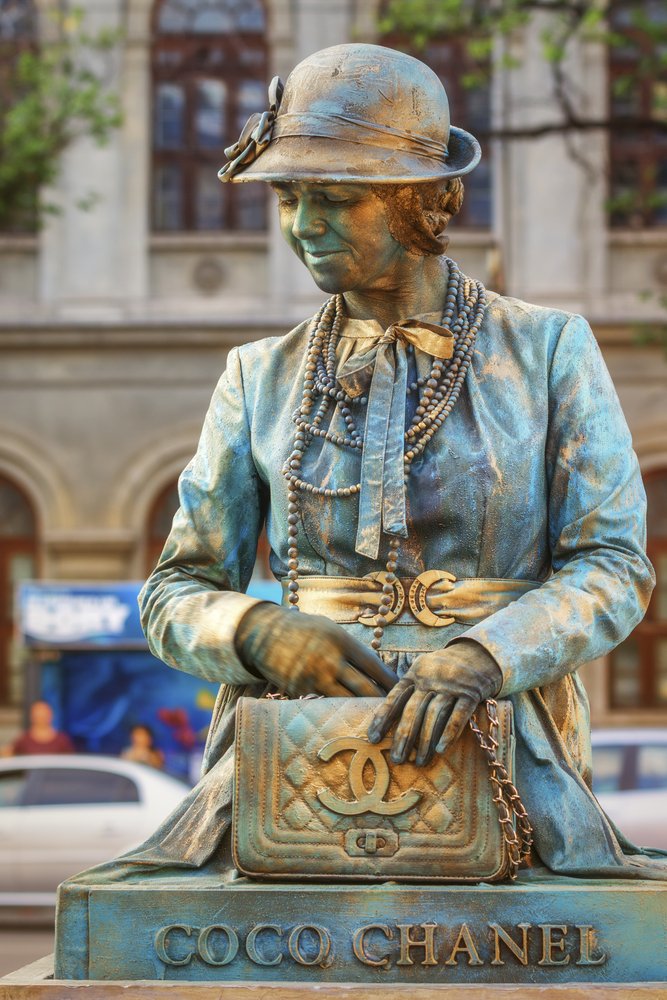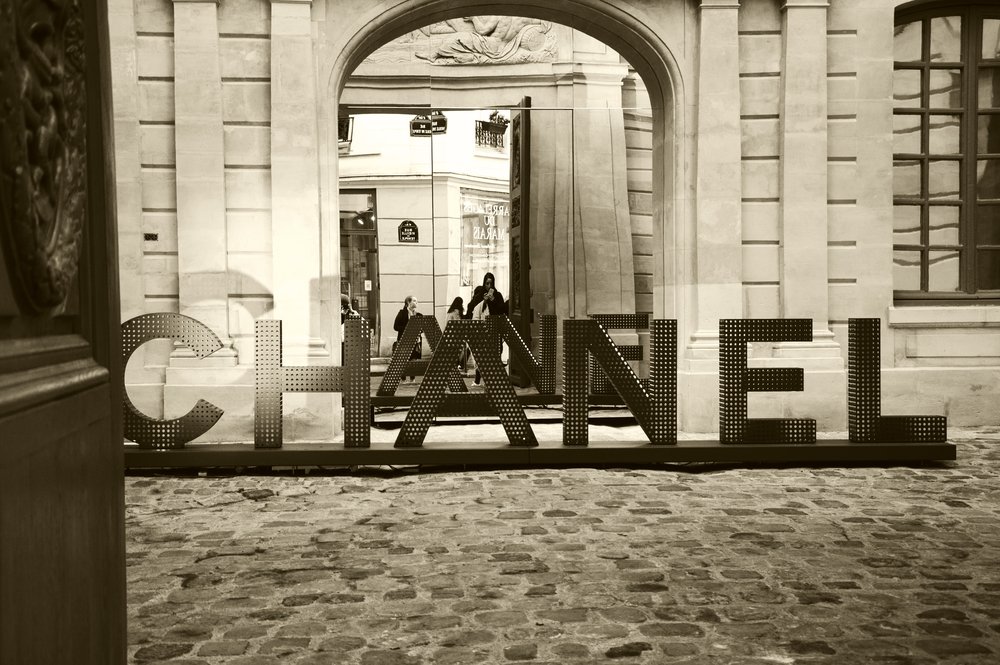- February 8, 2024
- fashionads@sxediomodas.com
- (0)
- Designer Spotlight
Table of Contents
Behind the Scenes with a Legendary Fashion Designer: The Timeless World of Coco Chanel
In the pantheon of fashion design, few names shine as brightly and enduringly as that of Coco Chanel. A maverick spirit whose influence transcends the fleeting trends of the fashion world, Chanel redefined the parameters of style and elegance for the modern woman. Born into modest beginnings, her journey to the zenith of fashion royalty is a testament to her unmatched creativity, relentless work ethic, and an unyielding desire to liberate women from the constraints of the corseted silhouettes of the 19th century. Chanel’s designs were not just garments; they were declarations of independence, whispers of comfort, and shouts of simplicity that resonated with women across the globe.
This article delves deep into the heart of Chanel’s legacy, uncovering the stories behind her iconic creations and the principles that guided her revolutionary approach to fashion. From the humble beginnings of her millinery shop to the global empire that the House of Chanel would become, we explore the enduring allure of Chanel’s designs and how they continue to influence fashion today. Join us as we pull back the curtain on the life of Coco Chanel, revealing the determination, the passion, and the vision of a woman who dared to change fashion forever.
Coco Chanel : A Legendary Fashion Designer
The Humble Beginnings: From Orphan to Icon

Gabrielle Bonheur “Coco” Chanel’s journey to becoming a titan of the fashion world began in the most unassuming of circumstances. Born on August 19, 1883, in Saumur, France, to a laundrywoman and a street vendor, Chanel’s early life was steeped in hardship and tragedy. At the tender age of twelve, after the death of her mother, Chanel was sent to the orphanage of the Cistercian Abbey of Aubazine, where she was raised by nuns. It was within these austere walls that Chanel received her first lessons in sewing—a skill that would become the cornerstone of her fashion empire.
Despite the scarcity of her early years, Chanel’s time at the orphanage was instrumental in shaping her design aesthetic. The simplicity and cleanliness of the nuns’ habits, along with the stark, geometric patterns of the abbey’s stained glass windows, would later influence her minimalist approach to fashion. Chanel’s upbringing instilled in her a profound understanding of the beauty in simplicity, a principle that would guide her throughout her career.
Emerging from the shadows of her childhood, Chanel’s ambition and talent propelled her into the cafes and cabarets of Moulins and then to the bustling city of Paris. In these early days, Chanel’s singing performances earned her the nickname “Coco,” a moniker that would become synonymous with fashion innovation and elegance. Yet, it was her visionary approach to women’s wear that would truly set her apart.
In 1910, with the financial support of her then-lover, Étienne Balsan, Chanel opened her first shop on Paris’s fashionable Rue Cambon. Initially focusing on millinery, Chanel’s hats quickly caught the attention of Paris’s elite. This early success was a mere glimpse of what was to come. Chanel’s relentless work ethic, coupled with her unorthodox views on women’s fashion, set the stage for a revolution in the way women dressed and perceived themselves.
Chanel’s ascent from an orphan to an icon is a narrative of determination, innovation, and the transformative power of fashion. Her early experiences, both the struggles and the modest triumphs, laid the foundation for a legacy that would redefine the fashion industry. As we delve deeper into Chanel’s life and career, it becomes clear that her humble beginnings were not merely obstacles to overcome but the very roots of her revolutionary approach to fashion.
Coco Chanel : A Legendary Fashion Designer
The Birth of a Vision: The Opening of Chanel's First Shop


In the heart of Paris, a city synonymous with art, culture, and fashion, Coco Chanel embarked on a journey that would forever alter the landscape of the fashion industry. The year was 1910, a time when Parisian fashion was dominated by extravagant, often cumbersome, designs. Against this backdrop, Chanel’s vision of elegance, simplicity, and comfort seemed revolutionary. It was with this vision that she opened her first shop at 21 rue Cambon, not as a fashion boutique, but as a millinery studio. This modest beginning marked the genesis of what would become a global fashion empire, symbolizing the birth of a new era in women’s fashion.
Chanel’s foray into the world of fashion was not a mere stroke of luck but a calculated move fueled by her unique blend of creativity, ambition, and entrepreneurial spirit. Her introduction to the Parisian elite, through her relationship with Étienne Balsan, a wealthy textile heir, provided her with the initial platform to showcase her talents. Balsan’s financial support and social connections were instrumental, yet it was Chanel’s distinct style and vision that captivated the fashionable society of Paris.
The early days of Chanel’s shop were focused on hat-making. Her designs stood out for their simplicity and elegance, starkly contrasting with the popular trends of the time, which favored elaborate and ornate accessories. Chanel’s hats quickly became a symbol of modernity and taste, worn by the most fashionable women of Paris, including famous actress Gabrielle Dorziat. This endorsement catapulted Chanel into the spotlight, establishing her as a rising star in the fashion world.
Recognizing the potential for expansion, Chanel’s ambitions soon led her beyond millinery. She began to experiment with clothing, applying her philosophy of simplicity and practicality to women’s attire. Chanel’s designs were revolutionary; she borrowed elements from men’s fashion, such as tailored jackets and simple blouses, and adapted them for women, offering an alternative to the restrictive corsets and cumbersome skirts that were prevalent at the time. Her use of jersey fabric, previously reserved for men’s underwear, was groundbreaking. It allowed for more comfortable, fluid garments that liberated women from the constraints of the era’s fashion.
1913 saw the opening of Chanel’s boutique in Deauville, a fashionable holiday resort. Here, Chanel’s sportswear collections, which included casual and practical designs suitable for the seaside, garnered attention and acclaim. This venture was a testament to Chanel’s intuitive understanding of her clientele’s desires for both comfort and chic in their wardrobes. The success of the Deauville boutique laid the groundwork for Chanel’s expansion, leading to the opening of another store in Biarritz in 1915, which further solidified her status as a fashion innovator.
Chanel’s approach to fashion was more than just designing clothes; it was about creating a lifestyle. Her designs reflected a shift in societal attitudes, championing the idea that women could be both elegant and free. Chanel herself embodied this philosophy, often wearing her creations, thus becoming a walking advertisement for her brand. Her personal style—characterized by a combination of sophistication, strength, and simplicity—resonated with women who sought to break free from traditional roles and express their individuality through fashion.
The opening of Chanel’s first shop was not just a commercial venture; it was the dawn of a new age in fashion. Through her designs, Chanel challenged and ultimately changed the societal norms surrounding women’s dress and, by extension, their roles in society. Her contribution to fashion was a blend of aesthetic innovation and cultural transformation, making her one of the most influential figures in the history of fashion.
As Chanel’s influence grew, so did her empire, extending beyond clothing to include perfumes, accessories, and jewelry, each carrying the hallmark of her minimalist elegance and timeless style. The legacy of the shop at 21 rue Cambon is monumental, marking the beginning of Chanel’s journey from a modest milliner to a global fashion icon. Through her resilience, creativity, and unwavering vision, Coco Chanel created more than just a brand; she crafted an enduring legacy that continues to inspire and captivate the world of fashion to this day.
Coco Chanel : A Legendary Fashion Designer
Redefining Women's Fashion: The Chanel Suit and the Little Black Dress

Coco Chanel’s indelible mark on the fashion landscape is perhaps most vividly captured in two of her most iconic contributions: the Chanel suit and the Little Black Dress (LBD). These creations not only showcased Chanel’s innovative approach to design but also her profound understanding of the modern woman’s desire for elegance, comfort, and functionality in her wardrobe. Through these designs, Chanel redefined women’s fashion, steering it away from the ornate and restrictive towards the streamlined and practical.
The Chanel Suit: A Symbol of Elegance and Empowerment
Introduced in the 1920s, the Chanel suit represented a radical departure from the typical women’s attire of the era. With its collarless jacket and well-fitted skirt, the suit exuded a simple elegance that was both modern and timeless. Chanel’s choice of fabric was also revolutionary; she favored tweed, a material traditionally associated with men’s clothing, for its durability and comfort. This decision not only blurred the gender lines in fashion but also elevated a utilitarian fabric to high fashion status.
The Chanel suit was more than just a piece of clothing; it was a statement of independence and empowerment for women. Its comfortable fit allowed for freedom of movement, a stark contrast to the constricting corsets and heavy skirts that had dominated women’s fashion. The suit’s clean lines and lack of superfluous decoration embodied Chanel’s philosophy that “luxury must be comfortable, otherwise it is not luxury.” It became a staple for the modern woman, symbolizing professional and social liberation.
The Little Black Dress: Revolutionizing Women’s Wardrobe
Equally transformative was Chanel’s introduction of the Little Black Dress in 1926. Prior to Chanel, black was reserved for mourning and considered inappropriate for other occasions. Chanel’s LBD, however, was a bold challenge to this convention. Featured in American Vogue, which likened it to the Ford car (“the frock that all the world will wear”), the LBD was a testament to Chanel’s visionary approach. Its simplicity, versatility, and affordability made it accessible to women of all social classes, democratizing fashion in a way never seen before.
The genius of the LBD lay in its adaptability; it could be dressed up or down depending on the occasion, making it a staple in every woman’s wardrobe. Its enduring popularity is a testament to Chanel’s understanding of the essential elements of timeless design. The LBD has been reinterpreted by countless designers over the decades, yet its essence remains unchanged, a tribute to Chanel’s original vision.
Legacy of Innovation
Both the Chanel suit and the Little Black Dress went beyond mere fashion items; they were manifestations of Chanel’s broader vision for women’s emancipation. By introducing practical yet stylish alternatives to the restrictive fashions of the past, Chanel played a pivotal role in the evolution of women’s clothing. Her designs were not only a reflection of the changing social and cultural landscape but also a catalyst for further change, encouraging women to see themselves as both beautiful and powerful.
Through the Chanel suit and the LBD, Coco Chanel redefined what it meant to be a stylish, modern woman. These pieces challenged the status quo, offering women a new form of expression that was both elegant and emancipatory. Chanel’s legacy, encapsulated in these iconic designs, continues to influence and inspire the fashion world, reminding us of the power of clothing to transform not only our appearance but also our sense of self.
Coco Chanel : A Legendary Fashion Designer
Chanel No. 5: A Fragrance Revolution
The creation of Chanel No. 5 in 1921 marked not just the birth of an iconic perfume but a revolution in the way fragrance was perceived and presented. Prior to Chanel No. 5, women’s perfumes were typically based on a single floral scent and were considered an accessory rather than a statement. Coco Chanel, with her characteristic flair for innovation and breaking norms, envisioned a fragrance that would embody the modern woman’s complexity and elegance. This vision gave rise to Chanel No. 5, a perfume that would forever change the olfactory world.
The Creation of a Legendary Perfume
Coco Chanel’s venture into perfumery was driven by her desire to encapsulate the essence of femininity in a bottle. She enlisted the expertise of Ernest Beaux, a renowned perfumer, to create something utterly unique. Chanel’s brief was clear: she wanted a perfume that “smells like a woman, not a flower bed.” Beaux took this challenge to heart, experimenting with various combinations before arriving at the groundbreaking formula that would become Chanel No. 5.
The innovation of Chanel No. 5 lay in its use of aldehydes, organic compounds that enhanced the scent’s complexity and longevity. This was a radical departure from the naturalistic fragrances popular at the time. The resulting perfume was a bouquet of over 80 scents, including jasmine, rose, sandalwood, and vanilla, with the aldehydes adding a layer of abstraction, making it indefinable and utterly modern. Chanel No. 5 was the first of its kind, a multi-faceted fragrance that represented the sophistication and depth of the women it sought to embody.
A Fragrance That Broke All the Rules
Chanel No. 5’s presentation was as revolutionary as its scent. Eschewing the ornate bottles typical of the era, Chanel opted for a simple, yet elegant, rectangular bottle with a minimalist label. This design choice reflected her belief in the beauty of simplicity and her desire to let the fragrance speak for itself. The bottle’s modernist aesthetic broke with tradition and set a new standard for perfume design, emphasizing the luxury and quality of the fragrance within.
Moreover, Chanel’s marketing of No. 5 was equally innovative. She leveraged her celebrity status and social connections to promote the perfume, making it a must-have accessory for the fashionable elite. Chanel No. 5 quickly became synonymous with sophistication and allure, a symbol of the modern woman who was both powerful and feminine.
The Enduring Legacy of Chanel No. 5
Chanel No. 5’s impact on the world of fragrance and beyond is immeasurable. It was the first perfume to be marketed as a symbol of luxury and feminism, setting the stage for the modern fragrance industry. Its success paved the way for numerous other Chanel fragrances, each embodying the house’s ethos of elegance and innovation.
The legacy of Chanel No. 5 is not just in its scent, but in its ability to capture the spirit of the times and to remain relevant across generations. It has been worn by celebrities, royalty, and women worldwide, becoming more than just a perfume; it is a cultural icon, representing the timeless allure of Chanel. Coco Chanel’s creation of No. 5 was a testament to her visionary genius, her understanding of women’s desires, and her unparalleled ability to redefine the boundaries of fashion and beauty. Chanel No. 5 stands as a monument to Chanel’s philosophy that “a woman should wear perfume wherever she would like to be kissed.
Coco Chanel : A Legendary Fashion Designer
Beyond Fashion: Chanel's Lasting Impact

The legacy of Coco Chanel extends far beyond the confines of fashion design and haute couture. Her visionary approach to style, her pioneering spirit, and her relentless pursuit of elegance and simplicity have left an indelible mark on the world. Chanel’s influence permeates various aspects of culture and society, making her more than just a designer; she is an icon of empowerment, innovation, and timeless style.
Redefining Femininity and Empowerment
Coco Chanel’s impact on women’s fashion was revolutionary, offering a new paradigm of femininity that combined elegance with comfort and practicality. Her designs liberated women from the restrictive corsets and elaborate gowns of the early 20th century, promoting a sense of freedom and independence that reflected the changing societal roles of women. The Chanel suit and the Little Black Dress became symbols of the modern woman—confident, sophisticated, and unapologetically herself.
Chanel’s philosophy extended beyond her designs. She embodied the very essence of the empowered woman she dressed, running a successful business in a male-dominated industry and living life on her own terms. Her success served as an inspiration for generations of women, encouraging them to pursue their ambitions and break free from societal expectations.
The Chanel Brand: A Symbol of Luxury and Innovation
The House of Chanel remains at the forefront of the fashion industry, a testament to Coco Chanel’s enduring legacy of innovation and excellence. Under the guidance of visionary designers like Karl Lagerfeld and Virginie Viard, the brand has continued to evolve while staying true to its founder’s ethos of simplicity, elegance, and timeless style. Chanel’s contributions to fashion—such as the introduction of jersey fabric, the popularization of the tweed jacket, and the creation of iconic fragrances—have become hallmarks of luxury and sophistication.
Cultural and Artistic Influence
Chanel’s influence extends beyond the runway to shape cultural and artistic dialogues. She collaborated with artists, filmmakers, and ballets, blending the worlds of fashion, art, and culture. Her friendships with figures such as Pablo Picasso, Jean Cocteau, and Igor Stravinsky highlight her role as a muse and patron of the arts, further cementing her status as a cultural icon.
Chanel’s personal style and philosophy have been the subject of numerous books, films, and exhibitions, showcasing her life’s work and her impact on fashion and society. Her story is one of resilience, creativity, and the relentless pursuit of beauty, serving as a source of inspiration for designers, artists, and women around the world.
A Legacy of Timeless Elegance
Coco Chanel once said, “Fashion fades, only style remains the same.” This statement encapsulates the essence of her legacy—a legacy defined by a commitment to timeless elegance and an understanding of the intrinsic beauty in simplicity. Chanel’s designs transcended the fleeting trends of fashion to become enduring symbols of style and sophistication.
As we look at the world of fashion today, the influence of Coco Chanel is unmistakable. Her principles of comfort, functionality, and elegant simplicity continue to resonate, making her work as relevant today as it was over a century ago. Beyond the iconic products and the global brand, Chanel’s greatest legacy is perhaps the freedom she bestowed upon women—the freedom to express themselves, to embrace their power, and to navigate the world with confidence and grace. Coco Chanel did not just change fashion; she changed the way women see themselves and their place in the world.
Coco Chanel : A Legendary Fashion Designer
Conclusion
Coco Chanel was not just a fashion designer; she was a visionary who forever changed the way women dress and perceive themselves. Her legacy is not just in the clothes, perfumes, or accessories that bear her name but in the spirit of independence and innovation that she instilled in the world of fashion. Chanel’s story teaches us that true style is timeless, and simplicity is the ultimate sophistication.
